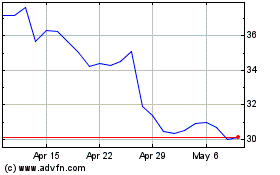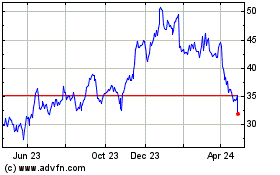Join Intel at Hot Chips, a conference on high-performance
microprocessors and related integrated circuits, where Raja Koduri,
senior vice president, chief architect and general manager of
Architecture, Graphics and Software, will deliver a keynote
presentation explaining the opportunities for hardware-software
co-design. Together with partners and customers, Intel is building
the trusted foundation for computing in a data-centric world.
Hot Chips 2020 When: Sunday, Aug. 16 — Tuesday, Aug 18,
2020 Where: Virtual Event Registration
Keynote: No Transistor Left Behind Raja Koduri
When: Monday, Aug. 17, 2-3 p.m. While silicon technology
scaled exponentially over the past few decades, the breadth and
depth of the software stack scaled at a much faster rate than could
have been predicted by Moore’s Law, bringing inefficiencies and
leaving plenty of room for increasing performance. In this keynote,
Raja Koduri will explore opportunities in hardware-software
co-design from the edge to the cloud to fully leverage the
transistors that are left behind by the incredible pace of software
change at the top of the stack.
Towards a Large-Scale Quantum Computer Using Silicon Spin
Qubits James S. Clarke When: Sunday, Aug. 16, 3:15-3:45
p.m. James S. Clarke, director of quantum hardware at Intel, will
present progress toward the realization of a 300mm Si-MOS based
spin qubit device in a production environment. In addition, this
talk will focus on a key bottleneck to moving beyond today’s
few-qubit devices: the interconnect scheme and control of a large
quantum circuit. To address this bottleneck, at Intel we have
developed customized control chips, optimized for performance at
low temperature, with a goal of simplifying wiring of quantum
systems and replacing the racks and racks of discrete electrical
components.
Next Generation Intel Xeon(R) Scalable Server Processor:
Icelake-SP Irma Esmer Papazian When: Monday, Aug. 17,
9:30-11:30 a.m. Irma Esmer Papazian, senior principal engineer in
architecture at Intel, will present on the next generation Intel®
XeonTM processor (code named “Icelake-SP”), a general-purpose
server processor designed to bring significant performance boost
over prior-generation Xeon processors. Icelake-SP is the first Xeon
server implemented on Intel 10nm processor technology and is
targeted for the end of 2020. Irma will describe new enhancements
to Icelake-SP, including ISA, security technologies and core
microarchitecture improvements, diving into their use and impact in
server application. She will also highlight key features,
microarchitecture insights and performance trends of Icelake-SP not
shared previously.
Inside Tiger Lake: Intel’s Next Generation Mobile Client
CPU Xavier Vera When: Monday, Aug. 17, 12-1 p.m. Xavier
Vera, principal engineer and SoC/performance power architect at
Intel, will lead a discussion on Tiger Lake, Intel’s next
generation mobile client CPU. Tiger Lake provides the best
performance and battery life Intel has ever offered for mobile
content creation, productivity and gaming usages. The new
high-performance core in Tiger Lake is called Willow Cove, which
adds enhanced security features to help protect against
return-oriented programming attacks along with increases in
performance via frequency push and L2 cache size increases. Intel®
Xe-LP is the new graphics engine within Tiger Lake that increases
the maximum number of execution units from 64 to 96. Xavier will
cover how Tiger Lake was able to achieve significant gains in
performance and drive competitive battery life.
The Xe GPU Architecture David Blythe When: Monday,
Aug. 17, 5-6:30 p.m. David Blythe, Intel senior fellow and director
of Graphics Architecture, will discuss Xe, Intel’s next-generation
GPU architecture. Xe was designed for scalability – spanning
teraflop to petaflop compute performance – and is slated for use in
multiple Intel products including Tiger Lake Client SoC and HPC GPU
Ponte Vecchio. In this presentation, he will explain the principles
behind Xe configurability and scalability and its many efficiency
enhancements, as well as new capabilities, including hardware
acceleration support for ray tracing, matrix/tensor processing and
multidie/multipackage connectivity. Blythe will then delve into
details for one configuration of the architecture, Xe-LP, employed
in lower TDP product segments.
Agilex Generation of Intel FPGAs Ilya Ganusov and Mahesh
A. Iyer When: Tuesday, Aug. 18, 8:30-10 a.m. Ilya Ganusov,
senior principal engineer and director of Programmable Architecture
at Intel, and Mahesh A. Iyer, Intel fellow in the Data Platforms
Group and chief architect and technologist of Electronic Design
Automation, will provide an in-depth technical disclosure of
Intel’s next-generation Agilex™ FPGA platform. Agilex™ FPGAs
deliver over 40% higher peak performance and use 40% less power, on
average, over prior generation Stratix®10 FPGAs. Details on volume
production shipment on engineering samples of Agilex™ FPGAs will be
revealed in the presentation.
Tofino2 – A 12.9Tbps Programmable Ethernet Switch Anurag
Agrawal and Changhoon Kim When: Tuesday, Aug. 18, 10:30
a.m.-12:30 p.m. In this presentation, Anurag Agrawal, senior
principal engineer in the Barefoot Division of the Data Center
Group, and Changhoon Kim, Intel fellow in the Connectivity Group
and chief technical officer of applications in the Barefoot Switch
Division, will describe Tofino2, a 12.9Tbps fully-programmable
switch silicon that is an evolution of the original Tofino
architecture in both speed and capability. Enhancements to Tofino2
include an increase in fungible resources and the addition of
several novel primitives to help users realize new types of
networking protocols and functions, such as advanced telemetry,
advanced congestion control and flexible scheduling.
About Intel
Intel (Nasdaq: INTC) is an industry leader, creating
world-changing technology that enables global progress and enriches
lives. Inspired by Moore’s Law, we continuously work to advance the
design and manufacturing of semiconductors to help address our
customers’ greatest challenges. By embedding intelligence in the
cloud, network, edge and every kind of computing device, we unleash
the potential of data to transform business and society for the
better. To learn more about Intel’s innovations, go to
newsroom.intel.com and intel.com.
Software and workloads used in performance tests may have been
optimized for performance only on Intel microprocessors.
Performance tests, such as SYSmark and MobileMark, are measured
using specific computer systems, components, software, operations
and functions. Any change to any of those factors may cause the
results to vary. You should consult other information and
performance tests to assist you in fully evaluating your
contemplated purchases, including the performance of that product
when combined with other products. For more complete information
visit www.intel.com/benchmarks.
Statements in this document that refer to future plans or
expectations are forward-looking statements. These statements are
based on current expectations and involve many risks and
uncertainties that could cause actual results to differ materially
from those expressed or implied in such statements. For more
information on the factors that could cause actual results to
differ materially, see our most recent earnings release and SEC
filings at www.intc.com.
© Intel Corporation. Intel, the Intel logo and other Intel marks
are trademarks of Intel Corporation or its subsidiaries. Other
names and brands may be claimed as the property of others.
View source
version on businesswire.com: https://www.businesswire.com/news/home/20200814005087/en/
Bruce Fienberg 510-220-6461 bruce.fienberg@intel.com
Intel (NASDAQ:INTC)
Historical Stock Chart
From Mar 2024 to Apr 2024

Intel (NASDAQ:INTC)
Historical Stock Chart
From Apr 2023 to Apr 2024
